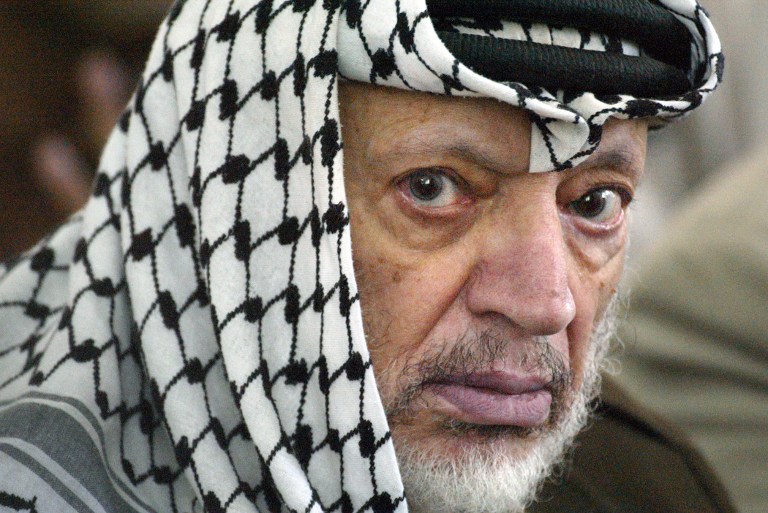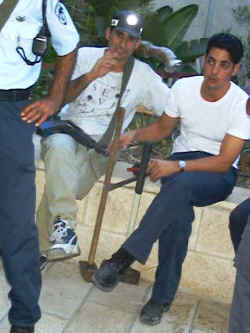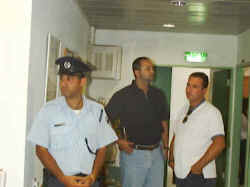The ‘Mischief Maker'[Scott Ritter] Bows Out
by Special Correspondent
Full Text
It was clear that the Iraqi officials waiting on the tarmac last December were nervous. A 15-man UN weapons inspection team was about to land at the Habanniya military base, some 65 kilometres west of Baghdad, and Scott Ritter, the “mischief maker, ” as he was called by the Iraqis, would be at the head of one of the teams.
True to form, instead of heading with the team to the UN’s Baghdad headquarters, Ritter steered his convoy, inspectors and their Iraqi minders, to a nearby tourist village where he asked for immediate access to the site. For the Iraqis, the request was not only bizarre but dubious. Habanniya Lake is a tourist site but is also part of President Saddam Hussein’s official family resort. The inspectors got in, conducted their cloak-and-dagger search, all the while ignoring Iraqi protests. They found nothing illegal.
The incident explains Iraq’s tense relationship with Ritter, who announced this week he was quitting the inspection teams. A former US marine intelligence officer, Ritter charged that United Nations Secretary-General Kofi Annan, the Security Council and the Clinton administration had stymied the inspectors on “the doorstep of uncovering Iraq’s weapons programme.”
In scathing criticism of Annan, Ritter accused the UN secretary-general of allowing his office to become a “sounding board for Iraqi grievances, real or imagined.” He also singled out the United States for failing to fight for the inspectors’ unrestricted access to suspected weapons sites. As for the Security Council, Ritter said it was not maintaining pressure on Iraq.
Iraqi newspapers rejoiced in Ritter’s bombshell announcement. They trumpeted his resignation as a triumph and the culmination of efforts to redefine the work of the United Nations Special Commission (UNSCOM), which Baghdad has repeatedly said is dictated by the US. Baghdad had accused Ritter of being a spy for the CIA and an agent for the Israeli intelligence, Mossad. It claimed he was serving American and Israeli interests and was seeking to prolong the economic sanctions against Iraq, which were imposed after its 1990 invasion of Kuwait.
In the wake of Ritter’s exit, Iraqi dailies reiterated the spy accusations but this time, they had something to back up their claims: reports in the American media that Ritter’s resignation was prompted by an FBI investigation that he had supplied information about UNSCOM to a foreign county, presumably Israel. They said his letter of resignation was “a noisy attempt” to blackmail the United Nations and the Security Council and cover up his Israeli links.
Long before his resignation, Ritter had become persona non grata in Iraq. In September 1997, he was turned away when he tried to inspect a presidential complex on the western bank of the Tigris River in Baghdad. The incident, which gave rise to the term “intrusive inspection, ” was repeated in March only a few weeks after Iraq’s Deputy Prime Minister Tarek Aziz and Annan signed an agreement to establish new rules for the inspections. Under the 11th-hour accord, which averted probable US military action, Saddam’s palaces and homes were to become accessible to UN inspections.
But it was in June, when Ritter tried to launch one of his inspections at a sensitive site in Baghdad, that the tables suddenly turned. Now it was Washington’s turn to object. President Bill Clinton’s administration had decided that it would no longer support such inspections and would adopt a new, less antagonistic policy towards Iraq. On 4 August, Secretary of State Madeleine Albright reportedly cautioned chief weapons inspector Richard Butler against mounting any surprise visits in Iraq. Indeed, the Washington Post reported that on at least six occasions Albright persuaded Butler to rescind orders for surprise searches in an effort to avoid a confrontation with Baghdad. That left Ritter singing out of tune.
Ritter labelled the policy shift a farce. In his resignation letter he wrote: “What is being propagated by the Security Council today in relation to the work of the Special Commission is such an illusion, one which, in all good faith I cannot and will not be a party to.”
Ritter later told an international news agency: “If we continue down this path, there will be a compromise solution. The Special Commission will be compelled to close files prematurely and the result will be that Iraq will be allowed to maintain weapons of mass destruction which they were called upon to get rid of by the Security Council.”
Ritter’s criticism has thrown the administration on the defensive. “What might the consequences be, in Iraq and around the world, of such appeasement, ” wrote the Washington Post in an editorial. “In this century we learnt through hard experience that the only answer to aggression and illegal behaviour is firmness, determination and when necessary action, ” it added. Similar articles appeared in other major American newspapers warning the administration against “letting Saddam get away with vitiating” the weapons inspections.
It has been a month since Saddam ordered a suspension of cooperation with UN inspectors. The world is now watching to see what will be America’s next move. In the wake of Ritter’s blitz, which prompted attacks, especially by hawkish congressmen, on the administration’s policy on Iraq, Albright wrote in the New York Times that the United States will stand firm on Iraq “no matter what.” What that means remains to be seen. For now, the Iraqi media will continue to delight in Ritter’s resignation and savour the moment.
Book Review
by Mahmoud El-Wardani
Full Text
Hekayit Al-Yahoud (The Story of the Jews), Zakaria El-Heggawi. Cairo: The Cultural Palaces Organisation, 1998
Heggawi dedicated his life to the study and collection of folkloric literature from oral or written sources. This book, which first appeared in 1967 and has recently been republished, was intended to be the first volume of an ambitious encyclopedia of Egyptian folklore, one which would document its motifs, recurring themes and so on. But Heggawi died before the project could ever materialise. This book, the putative first volume of an encyclopedia, concerns itself with the representation of the Jew in folk epics and popular sayings from Pharaonic to modern times, stopping at 1948 when, with the establishment of the state of Israel, the popular Egyptian image of the Jew changed radically.
A Sweet and Sour Summer
by Fatemah Farag
|
“The heat has not been kind to the colourful summer fruit. Fatemah Farag reports on the poor state of the fruit and vendors’ dispaior at the wholesale market.”
“All the heavy-duty carriers are women.”
|
Excerpts
Fruit, fruit and more fruit is what you will find in stall after stall of a large section of the Al-Obour wholesale market on the eastern outskirts of Cairo. The mundane bananas and oranges of the winter season have been replaced by exotic summer produce, including such delicacies as mangoes and figs.
“The four summer months are our peak season, ” said Adel, who has been in the business for the past 30 years. This year, however, everyone complains that one heat wave after another has taken a heavy toll on the luscious fruits and the profits they bring in.
At the unseemly hour of 4.30 am, Al-Obour is well lit and there is tension in the air.
The auction is the climax of the pre-dawn activity. “Every morning, seven days a week, we auction off the fruits of the day. Much of the summer produce, like figs, have to be brought in from farms on a daily basis, and sold immediately to retail dealers and consumers because they cannot be kept in storage, ” Adel explains.
Like many of the stall-owners, Adel sells the produce of farmers in return for a commission; hence his name komisyongi. (middle-man). Others sell their own produce, such as Faysal Moftah, who sells 75 different types of mangoes produced on his farms in Ismailia.
Buyers crowding around the crates include street vendors, fruit shop owners and agents for hotels and restaurants. For those who cannot afford the relatively high prices of the merchandise, crates of nearly rotten produce are piled out front. “These are bought by vendors who sell in [poor] neighbourhoods…, explains Adel.
But the category of those incapable of buying seems to be expanding. “We do not understand, ” complained Moftah. “According to the rules of economics, when supply is low, prices should go up. But this has not been the case at the market this year. Although the mango supply reaching the market is down by 70 per cent, the prices are a third of what they should be.”
According to Nasrallah Afifi, who brings figs from Al-Arish to the market, “It seems that people are unable to buy, which means that the wholesale dealer will not get his money back, and so we have to sell for less. If my produce remains, it goes bad and that is a disaster.”
Economics is not the only thing which seems to defy conventional orthodoxy at the market. “All the heavy-duty carriers are women, ” points out Moftah. Old or young, a woman can balance up to five heavy fruit crates on her head and walk a distance of about one kilometre to the car park many times a day. Aren’t men supposed to be stronger and better at such jobs? “Not here, ” is the enthusiastic answer. “Here, they [the women] are stronger and faster.” He forgot to add that they are probably much cheaper as well.
Nurturing Difference
Reviewed by David Blanks
Islam, Gender and Social Change
edited by Yvonne Yazbeck Haddad and John L. Esposito,
New York and Oxford,
Oxford University Press 1998
The editors are members of the Centre for Muslim-Christian Understanding, Georgetown University, Washington, D.C.
Excerpts
Throughout the post-colonial Muslim world gender has emerged as a central concern because the family is on the frontier.
It is the frontier… but the battle lines have been drawn between public and private space. Gender has been politicised precisely because women represent cultural autonomy. They are, for many, the standard bearers of tradition, the heralds of an indigenous Islamic legitimacy. This holds true across the region and across the political spectrum. Even relatively progressive, nominally secular states, which have adopted large parts of western legal codes, frequently leave family, marriage, and inheritance laws to the authority of Islamic jurisprudence. Egypt, Iraq, Jordan, Libya, Morocco, Tunisia and Yemen have ratified the United Nations’ Convention on the Elimination of All Forms of Discrimination Against Women, but some, Egypt included, have stipulated reservations about article 16 concerning the equality of men and women in matters relating to marriage and the family. According to Nadia Hijab “the fact that family law has developed within an Islamic framework means that Arab women can be equal outside the home but not within it.”
Several authors note that the subordination of women serves the patriarchal agenda of secularist and Islamist alike. In an engaging chapter on modern Egypt, Mervat Hatem argues that the secular and Islamist discourses share certain assumptions about gender roles. The secularists, who advocate civil society and civil government, feel that religion should be restricted to the spiritual realm — but in practice this means the domestic sphere. Although secularists fear that the creation of an Islamic state would put an end to the modern non-religious, non-gendered bases of citizenship; nonetheless, they have abrogated their responsibility for passing and enforcing adequate personal status laws.
Secularists and Islamists likewise share the belief that a woman’s place is in the home — albeit with a crucial difference in their underlying assumptions. Conservatives do not see gender as a final frontier between East and West, tradition and modernity; on the contrary, they would like to see the Islamic framework that is embodied in their understanding of gender extended to the public sphere as well. This does not mean, as Hatem contends, that Islamists are “anti-modern, ” as some critics have charged. In fact, she suggests, conservatives share with their ideological opponents some of the most important aspects of the modernist vision. In terms of women and the family, this translates into an insistence on education, science and professional knowledge as the basis of an Islamic upbringing.
Some {chapters} are aimed rather too much at a non-specialist, western audience. Thus for anyone living in or familiar with the Muslim world, Carol J. Riphenburg’s chapter on Oman will be disappointing. Culled mostly from secondary analyses and overly dependent upon an uncritical reading of religious texts, the essay comes off as somewhat naive.
{T}he author loses credibility when she asserts that “women in the Gulf area, unlike most parts of the Muslim East, have always received their assured shares of inheritance as designated in the Quran.” Similarly, she wrongly remarks that “throughout the Arab world, equal pay for equal work has been a long-standing tradition.”
Nadia Hijab, senior human development officer at the United Nations’ Development Programme… is cautiously optimistic. She is concerned that women are “in the unenviable position of having to choose between rights and respect” but is encouraged that “at last the debate on women’s roles is catching up with the reality of women’s lives.”
Translations by
Dr. Joseph Lerner,
Co-Director IMRA (Independent Media Review & Analysis)
P.O.BOX 982 Kfar Sava
Tel: (+972-9) 760-4719
Fax: (+972-9) 741-1645
imra@netvision.net.il









